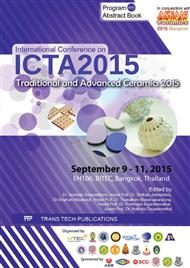p.18
p.23
p.28
p.33
p.39
p.45
p.51
p.57
p.65
The Fabrication and Dielectric Constant of (1-3) Piezoceramic Polymer Composites
Abstract:
Piezoceramic-polymer composites having (1-3) type connectivity and of a scale size suitable for high frequency >1 MHz transducers was carried out in this study. The piezoceramics (PbZr0.52Ti0.48O3, PZT) were prepared by the conventional mixed oxide route. The starting powders of PbO, ZrO2 and TiO2 were mixed and calcined at 800oC. The calcined powder was mixed with excess PbO and a lithium/bismuth-based glass forming in order to lower the sintering temperature to approximately 1000oC. A method for extruding rods of approximately 400 m diameter was developed. The fast firing process was carried out to sinter the PZT rods. Then the rods were assembled and impregnated with epoxy resin to form 1-3 composites containing approximately 20 and 50 vol% piezoceramics. Both PZT rods and the composites were studied by a scanning electron microscope (SEM). The dielectric properties of the composites were measured. The equivalent capacitance model was employed to determine the dielectric for comparison.
Info:
Periodical:
Pages:
39-44
Citation:
Online since:
May 2016
Keywords:
Price:
Сopyright:
© 2016 Trans Tech Publications Ltd. All Rights Reserved
Share:
Citation:


